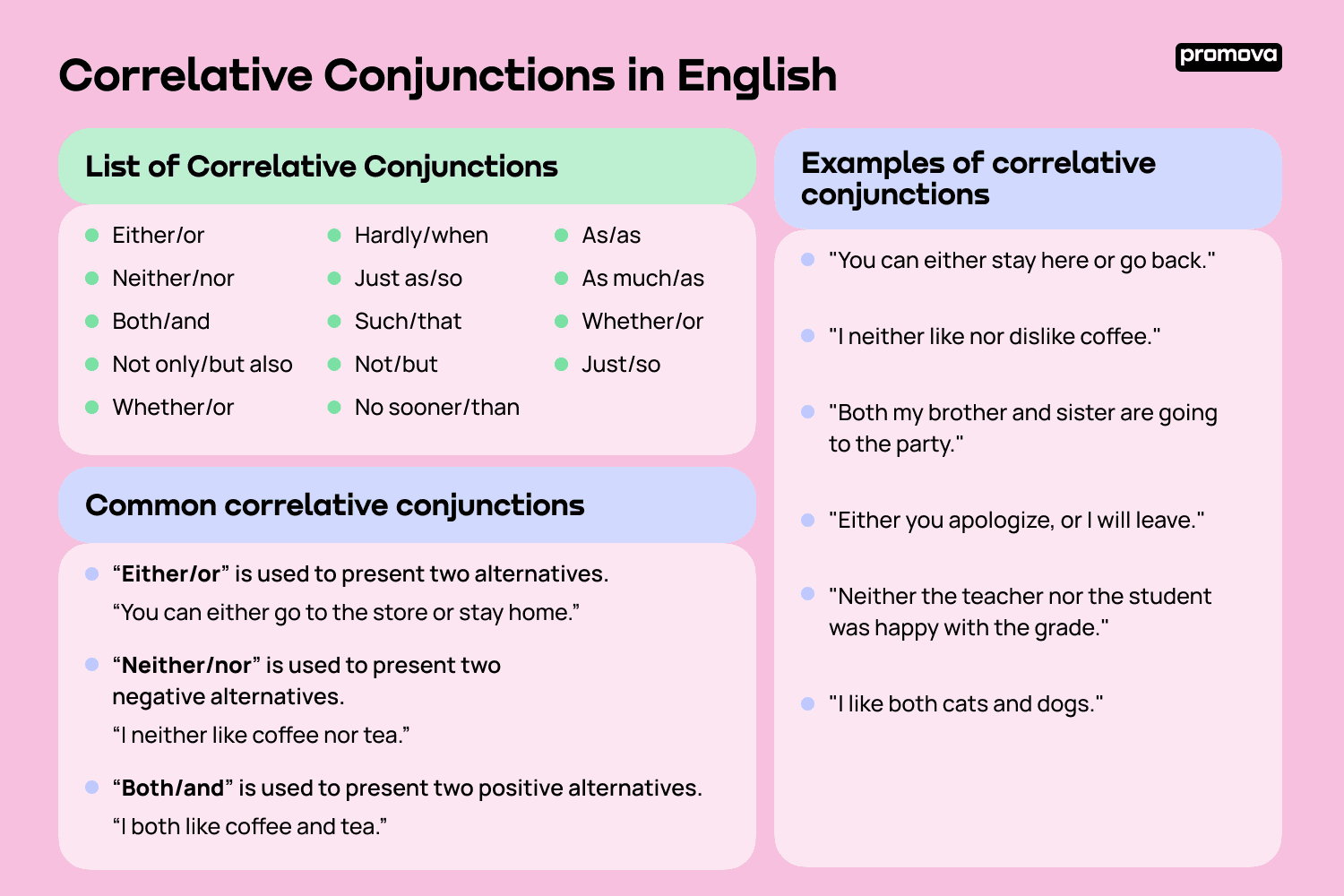Correlative Conjunctions in English
Contents
Correlative conjunctions are an important grammar tool for English language learners to understand! In this reference, we will discuss the various types of correlative conjunctions and how they are used in sentences.
What is a correlative conjunction?
A correlative conjunction is a pair of connecting words that are used together in a sentence to join similar or equal ideas. They can be used to connect two independent clauses, two adjectives, two nouns, two adverbs, or two phrases. It’s important to note that correlative conjunctions must be used in pairs. If you start a sentence with one correlative conjunction, you must use the other one at the end of the sentence.
For example, the correlative conjunction “both/and” is used to connect two ideas. If you start a sentence with “both,” you must end it with “and.”

Common correlative conjunctions
The most common words for you to learn are “either/or,” “neither/nor,” and “both/and.” These conjunctions can be used to make comparisons, show agreement, or explain choices.
- “Either/or” is used to present two alternatives. For example, “You can either go to the store or stay home.”
- “Neither/nor” is used to present two negative alternatives. For example, “I neither like coffee nor tea.”
- “Both/and” is used to present two positive alternatives. For example, “I both like coffee and tea.”
Examples of correlative conjunctions
Here are some examples of sentences using correlative conjunctions:
- "You can either stay here or go back."
- "I neither like nor dislike coffee."
- "Both my brother and sister are going to the party."
- "Either you apologize, or I will leave."
- "Neither the teacher nor the student was happy with the grade."
- "I like both cats and dogs."
Coordinating and correlative conjunctions
It’s important to distinguish between coordinating and correlative conjunctions. Coordinating conjunctions join two independent clauses, while correlative conjunctions are used to join two similar ideas.
So, let's take the coordinating conjunction “for.” For example, “I went to the store, for I needed to buy some food.”
On the other hand, the correlative conjunctions “either/or” would instead help join two similar ideas. For example, “You can either stay home or go to the store.”
Correlative conjunctions in sentences
When using correlative conjunctions, make sure that the two ideas being connected are similar. For example, if you’re using “either/or,” the two ideas should be similar, such as “You can either stay home or go to the store.”
Use them in the correct order. For example, the correlative conjunctions “either/or” should be used in this order: “either…or.” If you try to use “or…either,” it won’t make sense in the sentence.
Make sure that the correlative conjunctions are used correctly in terms of punctuation. For example, if you’re using “both/and,” use a comma before the “and” to separate the two ideas.
List of Correlative Conjunctions
Here is a handy list of all correlative conjunctions:
- Either/or
- Neither/nor
- Both/and
- Not only/but also
- Whether/or
- Hardly/when
- Just as/so
- Such/that
- Not/but
- No sooner/than
- As/as
- As much/as
- Whether/or
- Just/so
3
Common Mistakes
Here are some things to avoid:
- Using only one of the correlative conjunctions. Remember, correlative conjunctions must be used in pairs.
- Wrong order. Make sure to use the conjunctions in the correct order, such as “either/or” or “both/and.”
- Forgetting the punctuation. Make sure to use the correct punctuation when using correlative conjunctions, such as a comma before the “and.”
- Forgetting to use similar ideas. Remember, the two ideas connected by the correlative conjunctions should be similar.
Summary
Learning how to use correlative conjunctions correctly can take some time and practice. However, once you firmly get them into your vocabulary, it'll be a piece of cake! Remember that correlative conjunctions join two similar ideas, and they must be used in pairs. From there, you'll do well practicing with the most simple ones such as "either/or." Good luck on your learning journey!



Comments